To choose a bike helmet by head shape, start by measuring your head accurately at the widest point. If your head is round, look for helmets with adjustable systems that fit evenly without gaps or hot spots. For long oval heads, find helmets with elongated internal molds for a snug, level fit. Most people have intermediate oval shapes, which fit standard helmets well. Ensuring proper adjustment and checking for comfort will improve safety. Keep exploring to find tips tailored to your unique head shape.
Key Takeaways
- Measure your head circumference at the widest point, about 2 cm above eyebrows and ears, for accurate helmet sizing.
- Identify your head shape (round, oval, or long oval) to select a helmet designed for that profile.
- Choose helmets with internal molds or adjustability features that match your head shape for a snug, even fit.
- Ensure the helmet sits level, covers the forehead evenly, and doesn’t shift during movement for optimal safety.
- Use adjustable retention systems to fine-tune fit and eliminate hot spots, gaps, or pressure points.
Understanding Different Head Shapes and Their Characteristics
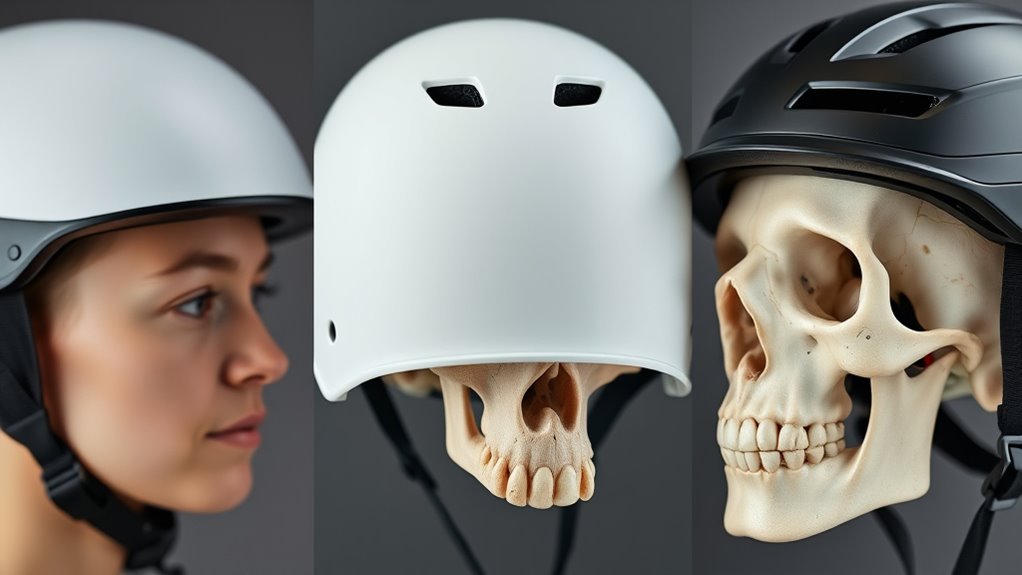
Understanding your head shape is key to finding a helmet that fits well and offers proper protection. Your head shape influences how helmets sit and feel during rides. Round head shapes are more spherical, with a uniform circumference, but they’re less common among riders. Most people have an intermediate oval head shape, which is slightly longer than wide, providing a balanced fit for many helmet styles. Long oval or elongated head shapes can create hot-spots at the forehead if the helmet isn’t designed for that shape, leading to discomfort. If your helmet doesn’t match your head shape, gaps and hot-spots can develop, reducing both comfort and protection. Knowing your head shape helps you choose a helmet that fits snugly and evenly, maximizing safety and comfort on every ride. Additionally, helmet fit and safety depend heavily on matching your head shape to the appropriate helmet design. Recognizing your head shape can also aid in finding helmets with adjustable features that accommodate your unique profile, especially considering that cost-effective helmet options are available for various head types.
How to Measure Your Head for an Accurate Fit
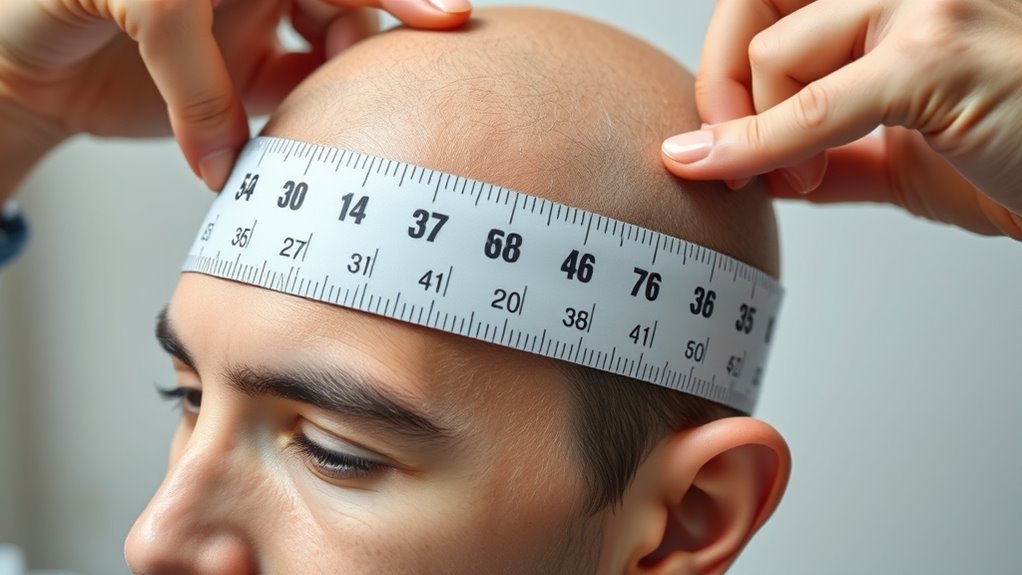
To get an accurate helmet fit, start by wrapping a flexible measuring tape around the widest part of your head, about 2 cm above your eyebrows and ears. Make sure the tape is snug but not too tight, lying flat against your skin without indenting. Record the measurement carefully and double-check to guarantee it’s precise before choosing your helmet size. Additionally, ensuring proper helmet fit can improve safety and comfort during rides. Properly fitting helmets are also made from durable materials that can withstand impacts and provide reliable protection. For optimal safety, consider that head shape influences helmet selection and comfort. Recognizing your Fokos head shape can help you select the most comfortable and secure helmet fit. Being aware of sleep and mental health can also help you maintain focus and alertness during your rides, contributing to overall safety.
Use a Flexible Measuring Tape
Using a flexible measuring tape is essential for getting an accurate head measurement. Wrap the tape around your head about 1 inch above your eyebrows and ears to measure your head circumference precisely. Make sure the tape is snug but not tight, and keep it level all around your head. An accurate measurement ensures you can compare it with helmet size charts effectively. Record your measurement in centimeters or inches, and double-check by measuring twice for consistency. This method helps you select the right helmet size within the fit system, preventing discomfort or inadequate protection. Always measure while standing upright in a well-lit area, avoiding hair accessories or hats. For optimal safety, proper helmet fit is crucial to ensure maximum protection in case of impact. Using a measuring tape correctly is the first step toward finding a helmet that fits comfortably and offers ideal safety. Remember, accurate measurements are the foundation for choosing a helmet that provides both comfort and safety. Additionally, understanding the benefits of proper fit can help you select the most protective helmet for your needs. Being aware of helmet safety standards can further guide you in choosing a reliable helmet that meets industry safety requirements. Incorporating head shape considerations can also improve the overall fit and comfort of your helmet.
Measure Above Eyebrows Accurately
Measuring your head above the eyebrows accurately is essential for selecting a properly fitting helmet. To do this, use a flexible tape measure and wrap it around your head approximately 1 inch (2.5 cm) above your eyebrows, where your forehead curves into your scalp. Keep the tape snug but not tight—allowing it to sit comfortably without compressing your head. Record the measurement where the tape overlaps, and double-check for accuracy. Using a mirror or asking someone to help ensures the tape stays level and parallel around your head. Take multiple measurements at different times to account for any variations, and always choose the largest measurement for sizing. This precise head circumference measurement guarantees a better fit and improved safety. Additionally, understanding how contrast ratio affects image quality can help in selecting the right projector for a home theater setup. Incorporating proper measurement techniques can further ensure the helmet fits securely and comfortably, and considering head shape can lead to a more personalized fit. Recognizing the importance of accurate measurements allows for better helmet safety and comfort, especially when considering body awareness in the fitting process.
Recognizing a Round Head Shape and Its Helmet Needs
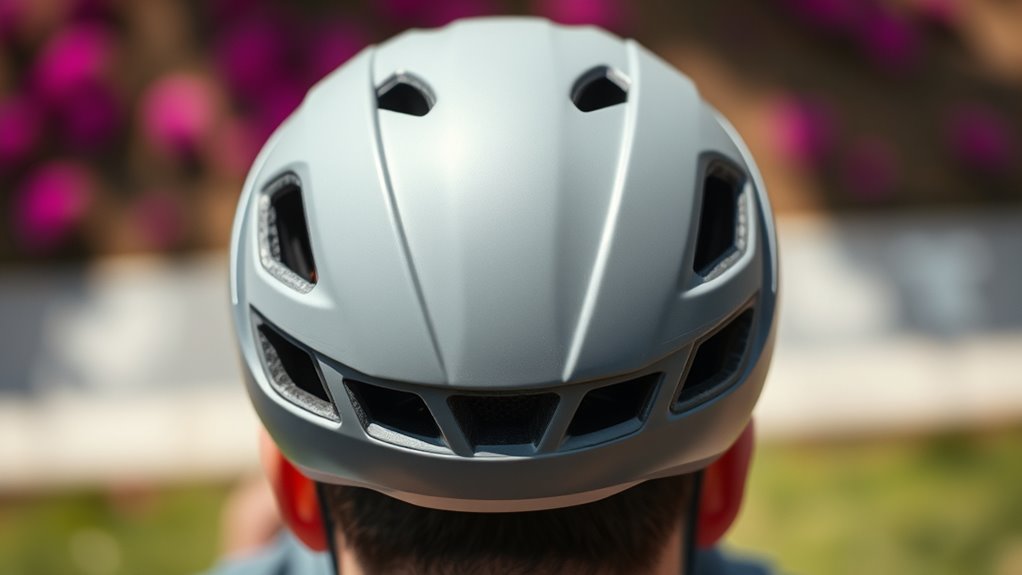
Have you ever wondered if your head shape influences the best helmet choice? Recognizing a round head shape is key. Look for these signs:
- Your head has a spherical profile, with similar width and length measurements.
- The helmet fits evenly around your head, without pressure points.
- You notice hot spots when the helmet is worn for a while.
- The retention system adjusts easily to keep the helmet snug and level.
- Proper helmet fit is essential for safety and comfort, ensuring the helmet stays in place during impacts.
A round head shape often benefits from helmets with adjustable retention systems that can customize fit. Because your head is less elongated, you don’t need specialized sizing but should choose helmets designed for a spherical profile. Proper fit prevents shifting during impacts, boosting safety and comfort.
Identifying an Intermediate Oval Head Shape and Suitable Helmets
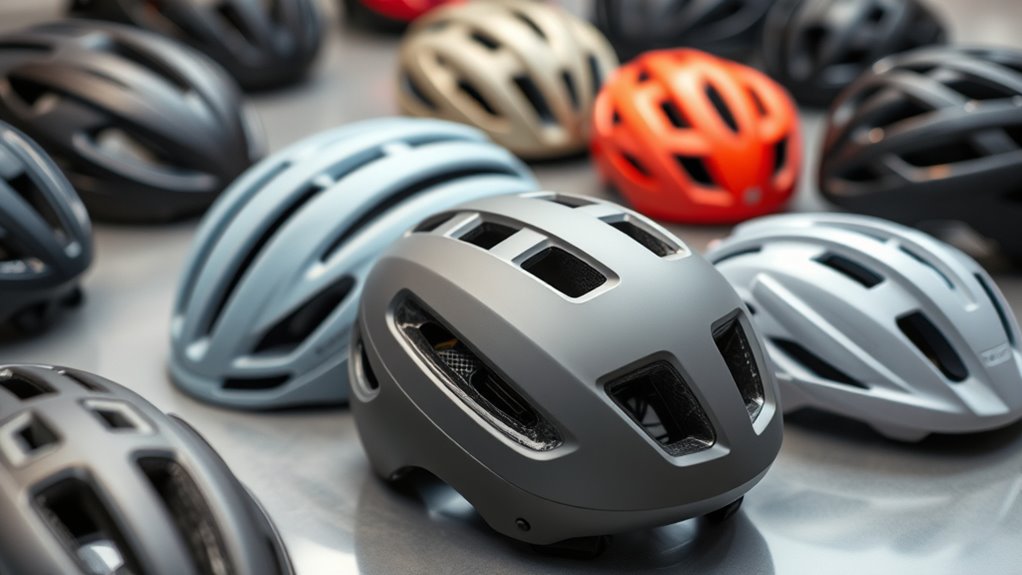
Since the intermediate oval head shape is the most common, most riders will find helmets designed for this profile to fit comfortably. You can identify this shape by noting that your head is slightly longer than it is wide. A properly fitting helmet for an intermediate oval should sit level, with the front edge no more than one inch above your eyebrows, without shifting side-to-side or front-to-back. Look for helmets with an adjustable retention system, so you can fine-tune the fit for added comfort and security. Most helmet brands, including Lazer and Giro, produce models tailored for intermediate oval head shapes, making it easier to find a helmet that offers a snug, comfortable fit that aligns with your head shape.
Finding the Right Fit for Long Oval Head Shapes
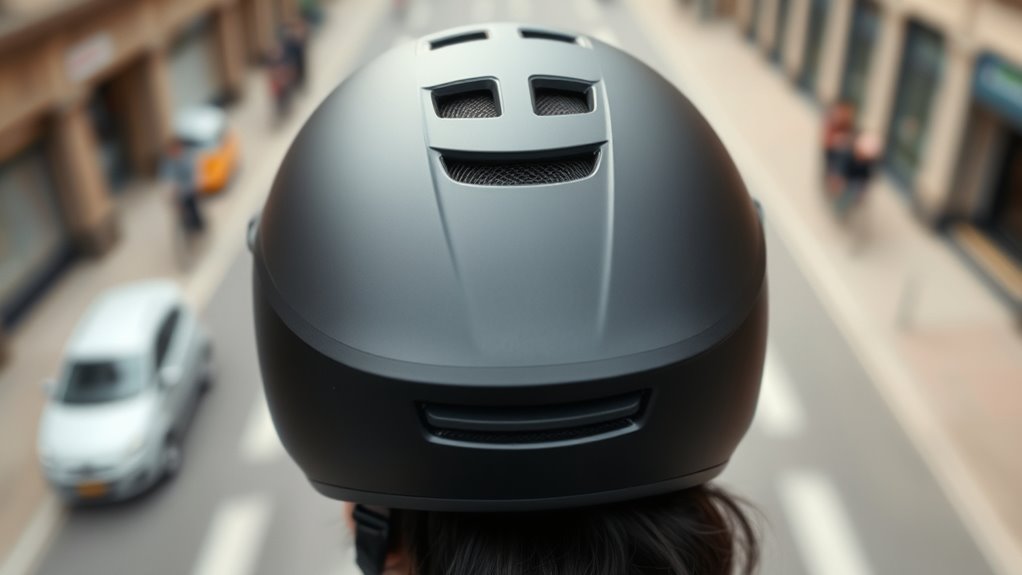
To find a helmet that fits long oval heads, look for options labeled as “Long Oval” or with adjustable fit systems. These helmets have an elongated internal shape that reduces pressure points and increases comfort. Trying on different models or consulting sizing guides helps make certain you get a snug, secure fit tailored to your head’s shape.
Suitable Helmet Shapes
If you have a long oval head shape, finding a helmet that fits properly is essential for safety and comfort. Look for helmets specifically designed with elongated internal molds to match your head shape. These helmets often feature:
- Narrower width but increased length to suit long oval head shapes
- Labels indicating “Long Oval” or “Elongated” for compatibility
- An adjustable fit system to fine-tune the helmet’s snugness
- A proper fit that sits level, with the front edge no more than one inch above your eyebrows, avoiding gaps or pressure points
Choosing a helmet that matches your head shape ensures better helmet fit, improves comfort, and reduces hot-spots. Prioritize these features to find a helmet that offers both safety and a secure, comfortable fit.
Proper Fit Adjustments
Proper fit adjustments are essential for long oval head shapes to guarantee your helmet provides maximum safety and comfort. To achieve this, choose long oval helmets with adjustable retention systems that allow precise tuning around your head’s shape. Proper fit helps prevent pressure points, especially at the forehead, which can cause discomfort and instability. Make certain the helmet sits level, covering your entire forehead without gaps on the sides. For ideal helmet fit, focus on adjusting the retention system so the helmet feels snug but not tight. Consider helmets labeled “long oval” or “extra-long” for better internal dimensions.
| Fit Adjustment Tip | Importance |
|---|---|
| Use adjustable straps | Ensures secure fit and reduces pressure points |
| Check helmet level | Maintains stability during riding |
| Select long oval helmets | Provides proper internal shell length |
Common Challenges With Different Head Shapes and Helmet Compatibility
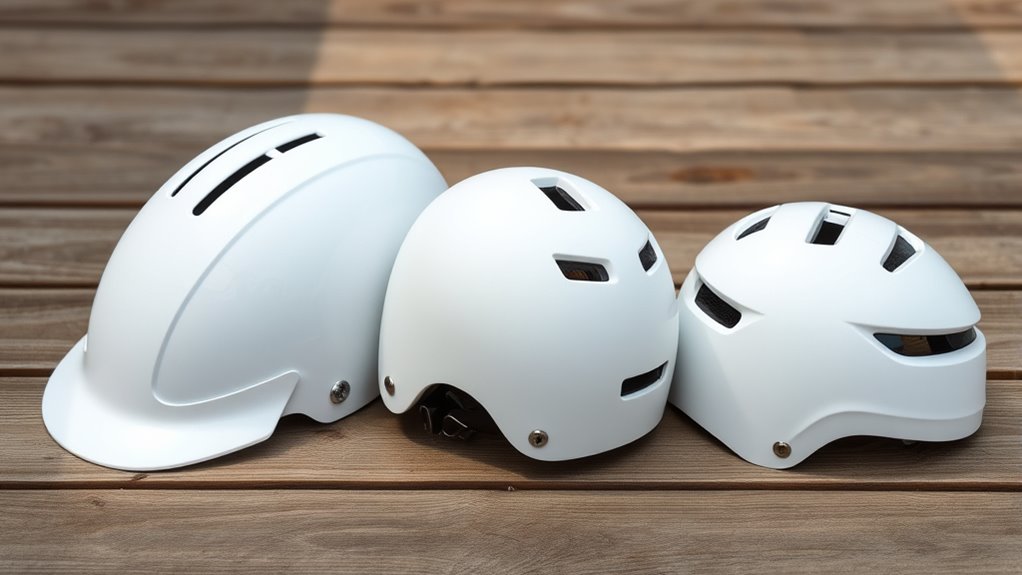
Choosing the right helmet can be challenging because different head shapes require specific designs for a secure and comfortable fit. If your head shape isn’t matched properly, you might face issues like:
- Hot spots—pressure points that cause discomfort during rides.
- Gaps—spaces between the helmet and your head, reducing impact protection.
- Shifting—a helmet that moves can compromise safety.
- Poor helmet fit—leading to discomfort and decreased impact absorption.
Round head shapes often experience hot spots and gaps with helmets designed for other shapes, while long oval heads need elongated helmets to avoid pressure points. Ensuring compatibility with your head shape is essential for maximum comfort, coverage, and safety.
Selecting Helmets Designed for Your Specific Head Shape

To find the right helmet, you need to match its shape to your head. Round helmets fit spherical heads perfectly, while long oval helmets suit elongated shapes. Choosing the correct design guarantees a comfortable, secure fit that keeps you safe on every ride.
Fit for Round Heads
If you have a round head, selecting a helmet specifically designed for your shape can make all the difference in comfort and safety. Round head helmets feature a spherical shape that offers a more uniform helmet fit, reducing hot spots and gaps. To guarantee proper impact protection, look for models with adjustable retention systems that can be fine-tuned to your spherical shape. When fitting your helmet, it should sit level on your head, with the front edge no more than one inch above your eyebrows. Make sure it doesn’t shift side-to-side or front-to-back. A well-designed helmet for round heads typically includes:
- Internal padding for a snug fit
- Adjustment systems for customization
- A spherical shape to match your head
- Secure, stable placement for safety
Helmets for Long Ovals
Helmets designed for long oval head shapes are crafted with elongated internal molds that conform better to heads that are noticeably thinner from side to side than they are long front to back. Long oval helmets help improve helmet fit by matching your head shape, reducing pressure points and hot-spots at the forehead. When selecting helmet sizing, look for models specifically made for long ovals to ensure a snug, secure fit that stays in place during rides. Many brands offer specialized long oval helmets with tailored padding and adjustable retention systems, enhancing comfort and stability. Properly fitted long oval helmets sit level and snug, with minimal movement side-to-side or front-to-back, maximizing both safety and comfort. Choosing the right helmet for your head shape makes all the difference in your riding experience.
Adjusting Helmets to Accommodate Unique Head Shapes
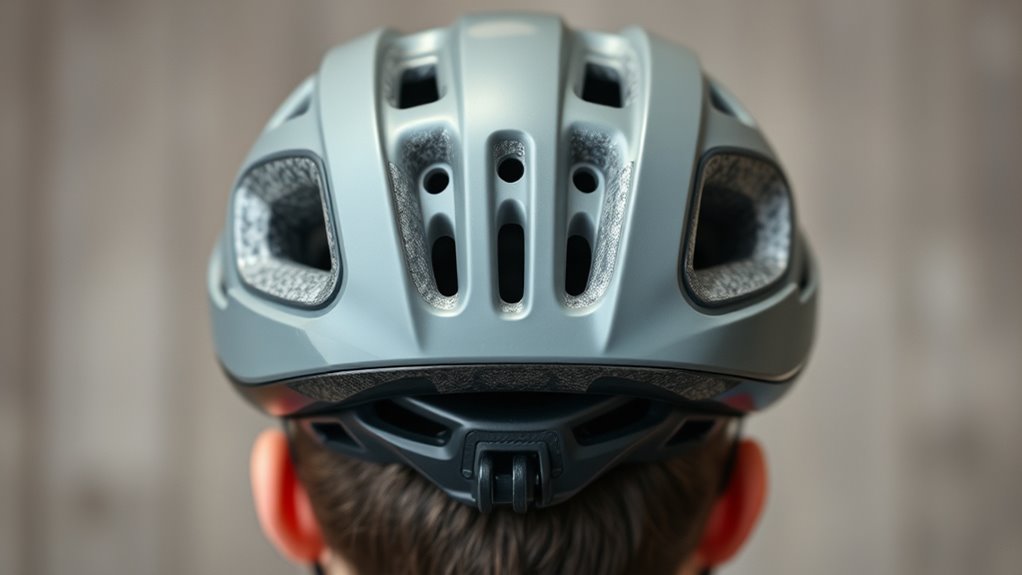
Adjusting your bike helmet to fit your unique head shape is essential for both comfort and safety. Proper helmet fit prevents pressure points, hot-spots, and gaps that can compromise protection. To optimize fit, consider these steps:
- Measure your head circumference accurately to determine your head shape category.
- Choose helmets with internal geometry designed for your shape—round, intermediate, or long oval.
- Use adjustable retention systems to tighten or loosen the fit, ensuring the helmet stays secure.
- Check for even contact around your head, avoiding areas of excessive pressure or gaps.
Tips for Ensuring Comfort and Safety on Any Head Shape
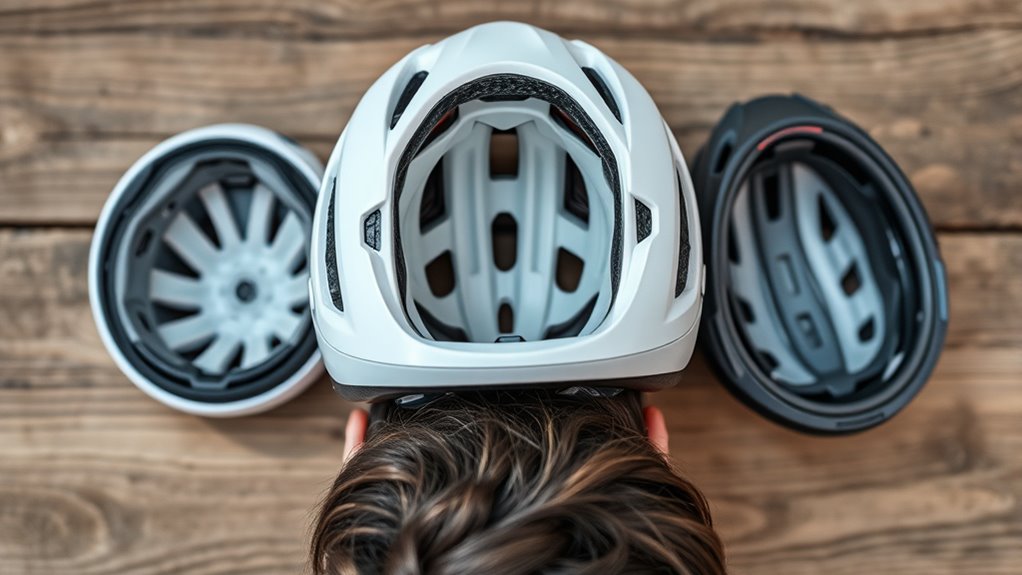
Ensuring comfort and safety on any head shape starts with selecting the right helmet that fits well and stays secure during rides. To achieve this, measure your head circumference 2 cm above your eyebrows and choose a helmet designed for your shape—round, intermediate, or long oval. Try on helmets with adjustable retention systems to fine-tune the fit and prevent shifting. Look for models with internal padding and customizable fit systems that distribute pressure evenly, reducing pressure points. Make certain the helmet sits level with the front edge no more than one inch above your eyebrows for ideal protection and comfort. Use the following table to help visualize key features:
| Fit System | Pressure Points | Adjustable Retention |
|---|---|---|
| Customizable padding | Even pressure distribution | Secure, personalized fit |
| Multiple size options | Reduced hot-spots | Easy to adjust |
| Designed for shape | Comfort during ride | Ensures proper fit |
| Internal padding | Comfort & safety | Keeps helmet stable |
| Proper sit alignment | Reduces discomfort | Prevents shifting |
When to Seek Professional Help for Helmet Fitting

You should seek professional help for helmet fitting whenever you experience persistent discomfort, pressure points, or find it difficult to adjust your helmet properly. A professional fitting guarantees your helmet matches your head shape for maximum safety and comfort. Consider consulting a specialist if:
- You notice pressure points or persistent discomfort during rides
- Your helmet shifts or moves excessively, despite adjustments
- You have an atypical head shape, such as long oval or irregular contours
- Your helmet is damaged, cracked, or involved in a crash
These signs indicate that a proper helmet adjustment or professional fitting is needed. Ensuring your helmet fits correctly helps prevent pressure points and provides better coverage, making all your rides safer and more comfortable.
Frequently Asked Questions
How Do I Determine My Head Shape for a Helmet?
To determine your head shape, start by measuring your head circumference with a flexible tape about an inch above your eyebrows. Then, observe whether your head looks more round, oval, or long oval by checking its shape from the front and side views, using a mirror or asking someone for help. Comparing these observations helps you identify your head shape, so you can pick a helmet that fits comfortably and securely.
What Is the 2 2 2 Rule When Fitting a Helmet on Your Head?
Think of fitting your helmet like tuning a guitar—tight enough to stay in tune, loose enough to be comfortable. The 2-2-2 rule helps you do this. You should be able to slide two fingers under the chin strap, and your helmet should sit level with two fingers’ width above your eyebrows. This ensures a snug, safe fit, so your helmet stays in place and protects you during your ride.
How to Choose the Correct Bike Helmet?
To choose the correct bike helmet, start by measuring your head circumference 2 cm above your eyebrows. Pick a helmet that fits snugly without pressure points, ensuring it stays level and doesn’t shift as you move. Use the adjustable retention system to fine-tune the fit, pressing comfortably against your head. Always follow the manufacturer’s sizing chart and position the helmet so the front edge is no more than an inch above your eyebrows for safety.
How Should a Bike Helmet Fit Your Head?
Did you know that a properly fitting helmet can reduce your head injury risk by up to 85%? When fitting your helmet, make sure it sits level, with the front edge no more than an inch above your eyebrows. It should be snug around your head without causing discomfort. Adjust the retention system so it doesn’t shift when you move, and ensure it presses gently when you open your mouth wide.
Conclusion
Now that you know how to identify your head shape and find the perfect helmet, you’ll ride with confidence and comfort, just like a knight preparing for battle in a medieval joust. Remember, a well-fitting helmet isn’t just about safety — it’s about enjoying your ride without any pesky discomfort. So, take your time, measure twice, and choose wisely. Your head’s comfort is worth the effort, ensuring many happy miles ahead!









